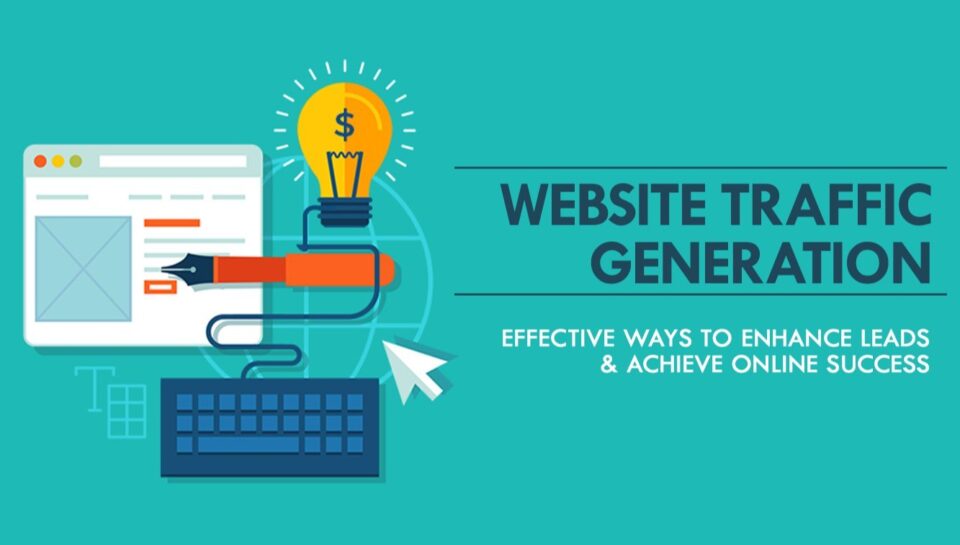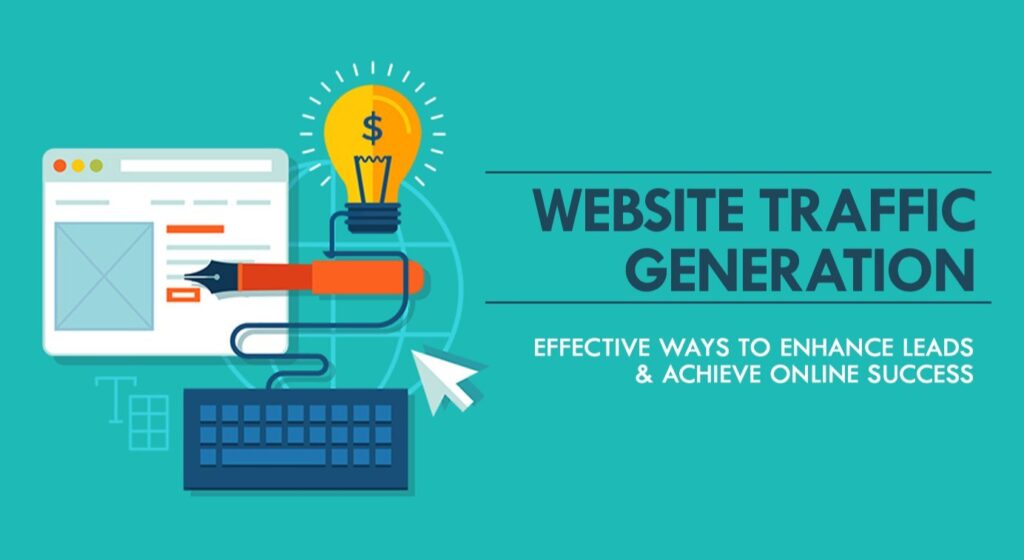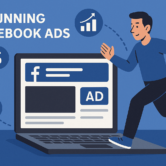- Your cart is empty Browse Shop

How to Generate Traffic to Your Website in 2025: Proven Strategies That Actually Work
Introduction
In today’s hyper-competitive digital landscape, generating traffic to your website remains one of the most significant challenges for businesses of all sizes. According to recent statistics, over 5.5 billion websites are competing for attention online, yet only 0.1% of them receive more than 50,000 monthly visitors! “Your website can have the most beautiful design and compelling content, but if no one sees it, it might as well not exist,” notes digital marketing expert Sarah Johnson. Whether you’re a seasoned entrepreneur or just starting your online journey, implementing the right traffic generation strategies is crucial for your business growth and sustainability. Generate traffic to your website.

Understanding Your Target Audience
Before diving into traffic generation tactics, it’s essential to have a crystal-clear understanding of who you’re trying to attract to your website.
I’ll never forget the time I spent three months aggressively pushing traffic to my first website. I was so excited watching my visitor count climb day after day! The analytics looked amazing – thousands of visitors were pouring in from my Facebook ads and SEO efforts. But here’s the kicker: my conversion rate was absolutely abysmal. Like, embarrassingly bad.
What went wrong? I hadn’t taken the time to truly understand who my ideal visitors were. I was just chasing numbers instead of quality. That expensive lesson taught me that traffic without targeting is just expensive noise. Generate traffic to your website.
These days, I start every traffic generation plan by creating detailed buyer personas. Trust me, this seemingly boring step saves so much heartache later! I sit down and think about my ideal visitors’ age, location, income level, pain points, and online habits. Where do they hang out online? What problems keep them up at night? What language do they use when searching for solutions?
One approach that’s worked wonders for me is conducting informal “interviews” with existing customers or people in my target demographic. Nothing fancy – just casual conversations where I ask about their challenges and how they search for solutions online. The insights are pure gold for crafting content that resonates. Generate traffic to your website.
Mastering SEO Fundamentals

Organic search remains one of the most powerful channels for sustainable website traffic growth.
Let me tell you something that might sound obvious but took me years to fully appreciate: search engine optimization isn’t a one-time thing you check off your to-do list. It’s an ongoing relationship with search engines that requires consistent attention and care.
My first real SEO disaster happened when I built what I thought was a “perfectly optimized” website for a client. I researched keywords, created content around them, and even built some decent backlinks. Traffic started flowing in, and I felt like an SEO genius! Six months later, everything crashed. Rankings disappeared, and traffic dried up almost overnight. Generate traffic to your website.
What happened? Google had released a major algorithm update, and I hadn’t been paying attention or adapting my strategy. I learned the hard way that SEO requires staying alert to industry changes and continuously refining your approach.
These days, my SEO strategy focuses on three core pillars: technical health, content quality, and user experience. I check my site’s technical foundations monthly using tools like Google site kit to catch crawlability issues before they become problems. For content, I’ve stopped obsessing over keyword density (that’s so 2010!) and instead focus on creating comprehensive resources that genuinely help readers solve problems. Generate traffic to your website.
The biggest game-changer for me has been prioritizing user signals like dwell time and bounce rate. When someone clicks on my site from search results and sticks around for a while, that sends powerful signals to Google that my content delivers what was promised. Small tweaks like breaking up text with subheadings, using bullet points, and adding relevant images have dramatically improved my engagement metrics.
Leveraging the Power of Social Media
Social platforms offer tremendous opportunities to drive targeted traffic to your website when approached strategically.
Oh boy, social media marketing. I’ve got a love-hate relationship with it that’s probably familiar to many of you! When I first started trying to drive traffic from social channels, I made the classic beginner mistake: I tried to be everywhere at once. Facebook, Twitter, Instagram, LinkedIn, Pinterest, TikTok—you name it, I was posting the same content across all platforms and wondering why nothing was sticking.
After burning out spectacularly (and wasting a ton of time), I took a step back and completely rethought my approach. The strategy that’s worked for me isn’t sexy or revolutionary, but it’s effective: go deep on just 1-2 platforms where your audience actually hangs out rather than going shallow on six.
For my niche in the productivity space, I discovered through trial and error that Instagram and Twitter drive the most qualified traffic to my website. Once I focused my energy there instead of trying to conquer every platform, my referral traffic tripled within two months! Quality over quantity makes such a difference.
Content repurposing has become my secret weapon for social media traffic. Instead of creating unique content for each post (which is exhausting), I’ll take a successful blog post and transform it into multiple social media pieces. One 2,000-word article might become 10 Instagram posts, each highlighting a different insight. This approach saves me tons of time while ensuring my social content drives people back to my website. Generate traffic to your website.
Content Marketing Excellence

Content remains king when it comes to attracting and engaging potential website visitors.
I still remember my first attempt at content marketing. I wrote what I thought was an amazing blog post, published it with a proud smile, and then… crickets. Absolutely nothing happened. No traffic, no comments, no shares. Talk about a reality check! That was the day I realized that the “build it and they will come” approach to content is a total myth.
What I’ve learned since then is that successful content marketing is equal parts creation and distribution. Creating killer content is only half the battle – you’ve gotta have a solid plan for getting eyeballs on that content too!
My biggest breakthrough came when I started thinking about content in terms of solving specific problems. Instead of writing broad, generic posts like “How to Use Social Media,” I started creating super-targeted content like “How to Create Instagram Stories That Convert Followers to Email Subscribers.” The more specific the problem I solved, the better my content performed in both search rankings and engagement metrics. Generate traffic to your website.
I’ve also become a huge believer in the power of content clusters. Rather than creating random, one-off pieces, I now build comprehensive content hubs around specific topics. For example, when targeting the keyword “email marketing,” I’ll create a pillar page that covers the topic broadly, then link it to more specific articles about email subject lines, segmentation strategies, automation sequences, and so on. This approach has dramatically improved my search visibility and keeps visitors on my site longer as they explore related content.
Another game-changer has been embracing multiple content formats. Not everyone likes to read long articles (shocking, I know!). Some prefer videos, podcasts, infographics, or interactive tools. By repurposing my best content into different formats, I’ve been able to reach audiences that would never have discovered my written content alone. My most successful piece of content started as a blog post, then became a YouTube video, a downloadable checklist, and eventually a webinar – each version reaching a different segment of my audience.
I used to be so precious about my content calendar, planning everything months in advance. But I’ve learned that some of the best-performing content comes from responding quickly to industry trends and news. Being agile enough to create timely, relevant content has helped me catch traffic waves that my more rigid competitors miss entirely. Generate traffic to your website.
One thing that’s been a total lifesaver is establishing a content creation process. I used to approach each piece as a unique project, which was incredibly inefficient. Now I have templates, checklists, and standard operating procedures that make creating high-quality content much faster. This consistency has not only saved my sanity but also improved the overall quality of my content.
Remember that great content doesn’t always mean new content. Some of my biggest traffic wins have come from updating and expanding existing content that was already performing well. This strategy gives me much more bang for my buck than constantly chasing new topics. Generate traffic to your website.
Paid Advertising Tactics
Strategic paid advertising can deliver immediate traffic boosts while you build organic channels.
I used to have a serious love-hate relationship with paid advertising. The instant traffic was addictive, but watching my budget drain away was painful – especially when the results weren’t what I hoped for. My first foray into Facebook ads was a complete disaster. I blew through 3500ksh in a week with barely any conversions to show for it. I was ready to write off paid advertising altogether!
What I didn’t realize then was that successful paid advertising requires a strategy, not just throwing money at platforms and hoping for the best. Since those early failures, I’ve developed a much more disciplined approach that’s transformed paid channels into predictable traffic sources for my business.
The breakthrough came when I stopped thinking about paid advertising as a standalone tactic and started integrating it with my overall marketing funnel. Now, instead of sending cold traffic directly to a sales page (rookie mistake!), I use paid ads to promote high-value content that addresses my audience’s pain points. This content-first approach builds trust and warms up prospects before asking for a sale. Generate traffic to your website.
I’ve learned that each advertising platform has its own strengths and ideal use cases. Google Ads works wonders for capturing high-intent traffic from people actively searching for solutions, while Facebook and Instagram ads excel at targeting specific demographics and interests. LinkedIn ads have been my go-to for B2B campaigns, despite the higher cost per click – the quality of traffic more than makes up for it. Generate traffic to your website.
Retargeting was a complete game-changer for my paid advertising results. Instead of focusing solely on acquiring new visitors, I now allocate about 30% of my ad budget to reconnecting with people who’ve already visited my website but didn’t convert. These campaigns consistently deliver the highest ROI since I’m targeting people who’ve already shown interest in what I offer.
One strategy that’s worked particularly well is creating custom audiences based on specific page visits or actions. For example, I might retarget everyone who visited my pricing page but didn’t purchase, or people who started but didn’t complete my lead magnet download form. This level of targeting allows me to address specific objections and nudge visitors back to my site to complete their journey. Generate traffic to your website.
A painful lesson I learned the hard way: never send paid traffic to a generic homepage! Every ad should direct visitors to a dedicated landing page that continues the conversation started in the ad itself. The messaging, imagery, and offer need to align perfectly to maximize conversion rates. I’ve seen conversion rates jump from 2% to over 10% just by improving this message match.
Testing has become an essential part of my paid advertising strategy. I never launch a campaign without multiple ad variations and landing page options to test against each other. Sometimes the results are surprising – the headline I was least confident about might outperform my favorite by a significant margin. Data doesn’t lie, and it’s helped me overcome my own biases about what works.
Budget management is another critical skill I’ve developed. Rather than spreading my budget thinly across multiple platforms, I now focus on mastering one channel at a time. Once I’ve achieved profitability on one platform, I’ll expand to another. This focused approach has given me much better results than trying to be everywhere at once.
Analytics and Optimization
Data-driven decision making is crucial for improving your traffic generation efforts over time.
I used to be completely overwhelmed by analytics. All those numbers, charts, and metrics made my eyes glaze over! For the longest time, I’d just log into Google Analytics, look at the total visitor count, and call it a day. What a wasted opportunity that was! Once I learned how to actually use analytics to drive decisions, everything about my traffic generation efforts improved dramatically.
My analytics journey started with a simple question: where is my most valuable traffic coming from? Not just the highest volume, but the visitors who actually stick around, engage with my content, and eventually convert. The answer surprised me. While social media was driving a lot of visits, organic search traffic had 3x higher conversion rates and much longer session durations. This insight completely shifted my content strategy to focus more heavily on SEO. Generate traffic to your website.
One of the best moves I made was setting up proper goal tracking. Instead of just monitoring pageviews, I started tracking specific user actions that indicated success – newsletter signups, resource downloads, contact form submissions, and so on. This changed everything about how I evaluated my traffic. A thousand visitors with zero conversions suddenly looked a lot less impressive than a hundred visitors with ten conversions!
I’ve learned that the most valuable metrics aren’t always the most obvious ones. For example, tracking returning visitors vs. new visitors gave me incredible insights into the stickiness of my content. When I noticed my returning visitor percentage was quite low, I implemented a content strategy specifically designed to encourage repeat visits. Within three months, my returning visitor rate had doubled, and those repeat visitors were converting at much higher rates. Generate traffic to your website.
Setting up custom dashboards has been a game-changer for my analytics workflow. Rather than wading through the default reports, I created focused dashboards that show exactly the metrics that matter most for my specific goals. This saves me tons of time and keeps me focused on the data that actually drives decisions.
Another breakthrough came when I started analyzing user paths through my website. I discovered several unexpected dead ends where visitors were dropping off. By adding strategic internal links and calls-to-action at these points, I was able to extend session duration and guide visitors toward conversion points they might otherwise have missed.
A/B testing has become an essential part of my optimization process. Rather than making changes based on hunches or assumptions, I now test different versions of key pages to see what actually performs better. Some of my biggest wins have come from seemingly minor tweaks – changing a button color, simplifying a form, or rewriting a headline. The cumulative effect of these small improvements has been dramatic growth in both traffic and conversions.
I used to look at bounce rate as a purely negative metric, but I’ve since learned that context matters enormously. A high bounce rate on a blog post might actually be fine if visitors are finding the information they need and leaving satisfied. On the other hand, a high bounce rate on a product page might indicate serious problems with your messaging or user experience. Understanding these nuances has helped me optimize the right things for the right reasons.
Mobile analytics deserve special attention in 2025. With mobile traffic accounting for over 70% of visits in many industries, I now analyze mobile and desktop experiences separately. This has uncovered mobile-specific issues that were hurting my overall traffic quality. Once addressed, these fixes improved both my search rankings (due to better Core Web Vitals) and my conversion rates on mobile devices. Generate traffic to your website.
Conclusion
Generating traffic to your website in 2025 requires a multi-faceted approach that combines both tried-and-true strategies and emerging techniques. By deeply understanding your audience, creating valuable content, optimizing for search engines, leveraging social media, and analyzing your results, you can build sustainable traffic sources that drive business growth.
As you implement these strategies, remember that what works for one website might not work for another. Pay careful attention to your analytics and be willing to pivot when the data suggests a change in direction. The most successful traffic generation comes from continuous testing, learning, and refining your approach. Generate traffic to your website.
Safety is also an important consideration, especially when implementing paid advertising strategies. Be mindful of privacy regulations like GDPR and CCPA, and always ensure your tracking and data collection practices are compliant with relevant laws in your region.
I’d love to hear about your own website traffic experiences! What strategies have worked best for your site? Have you discovered any unconventional traffic sources that delivered surprising results? Share your thoughts and questions in the comments below, and let’s learn from each other’s successes and challenges.
Remember, sustainable website traffic isn’t built overnight. Stay patient, stay consistent, and keep providing genuine value to your audience. The visitors—and customers—will follow.
website traffic strategies
increase website visitors
organic traffic generation
SEO traffic techniques Generate traffic to your website.
website visibility tips
drive targeted traffic
website traffic analytics
content marketing for traffic
social media traffic generation
email marketing for website traffic Generate traffic to your website.
PPC traffic strategies
search engine optimization 2025
website traffic conversion
link building for traffic
traffic generation tools
audience targeting techniques Generate traffic to your website.
website traffic measurement
traffic sources diversification
mobile traffic optimization
conversion rate optimization Generate traffic to your website.
local SEO traffic
voice search traffic
website engagement metrics
referral traffic strategies
traffic generation ROI
technical SEO for traffic
content distribution channels
traffic monetization strategies
website user experience
traffic quality measurement
keyword research for traffic
landing page optimization
traffic generation case studies
website authority building Generate traffic to your website.
traffic retention strategies
social sharing for traffic
blog traffic generation
website speed optimization
international traffic strategies
website traffic benchmarks
content promotion techniques
influencer marketing for traffic Generate traffic to your website.
traffic generation budget
competitive traffic analysis
website bounce rate reduction
traffic seasonality patterns
multimedia content for traffic Generate traffic to your website.
long-term traffic strategies
traffic generation mistakes
website traffic forecasting
search engine algorithms





